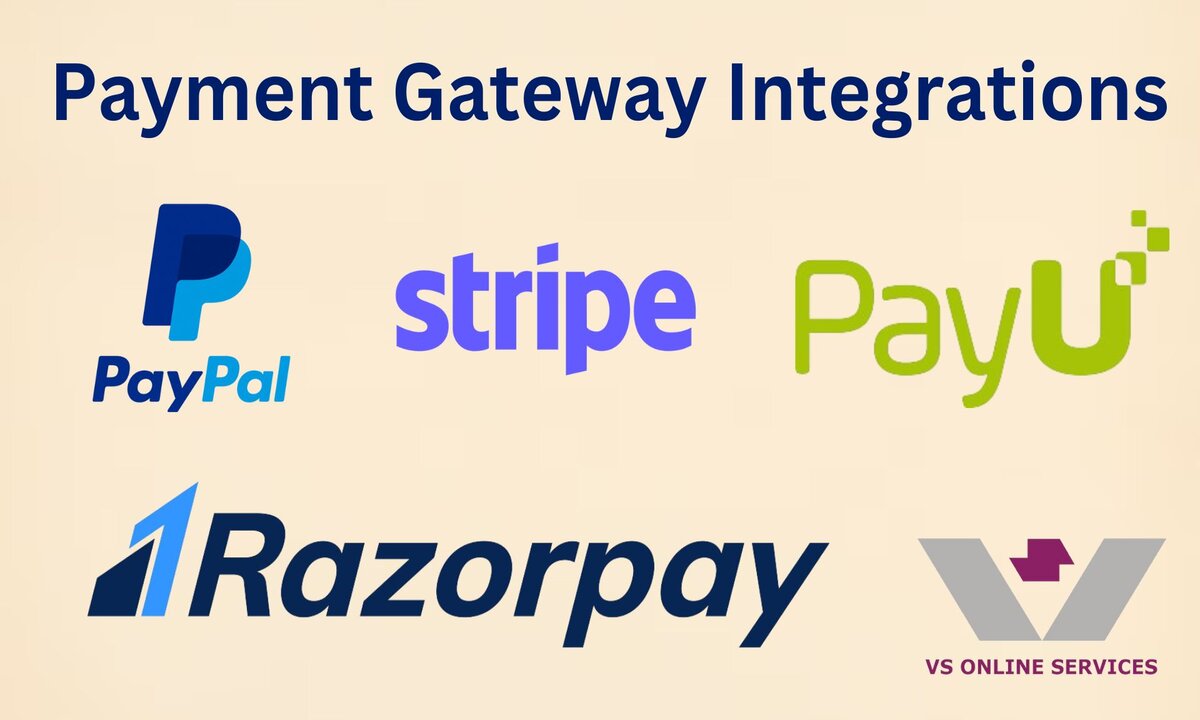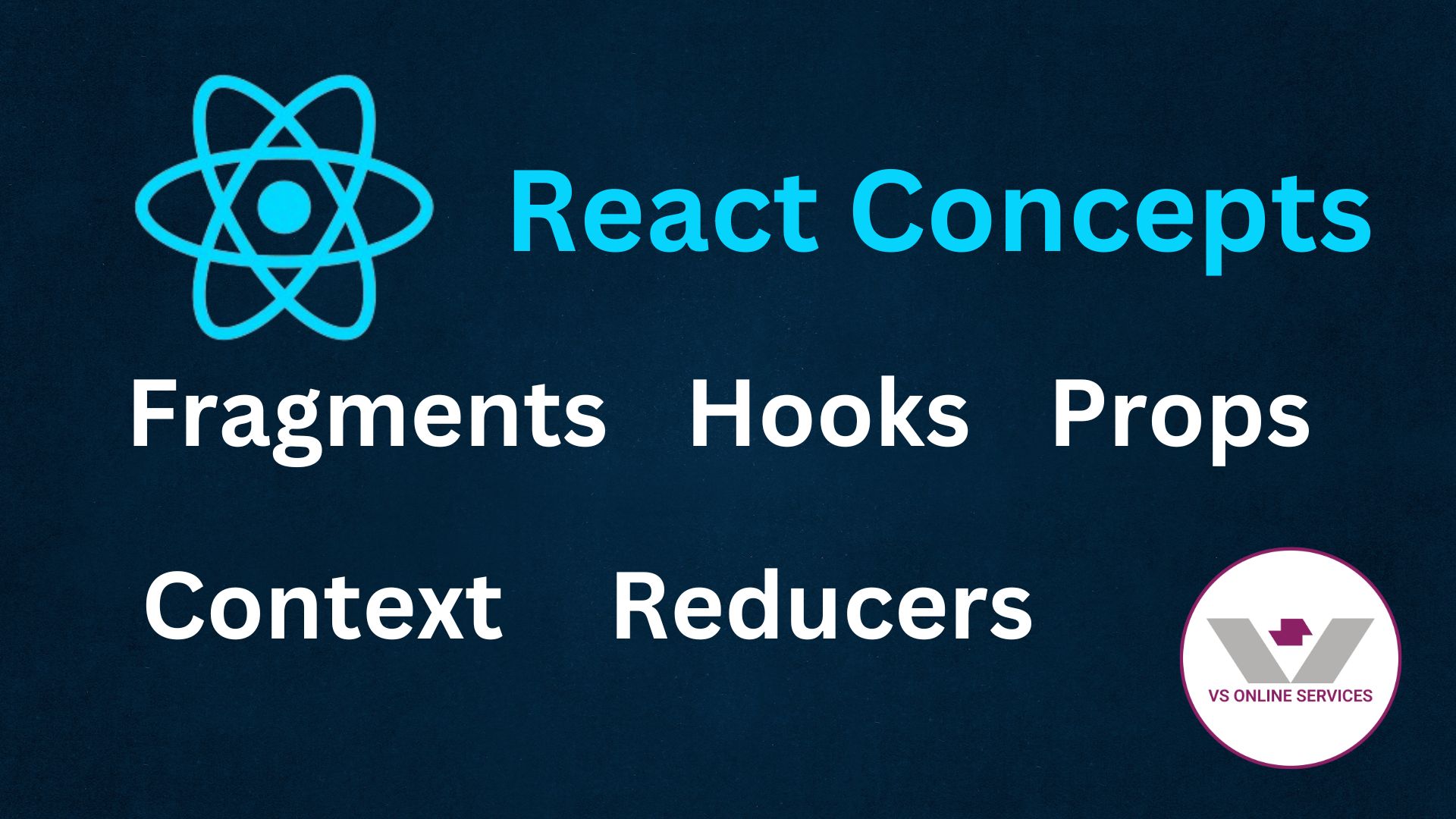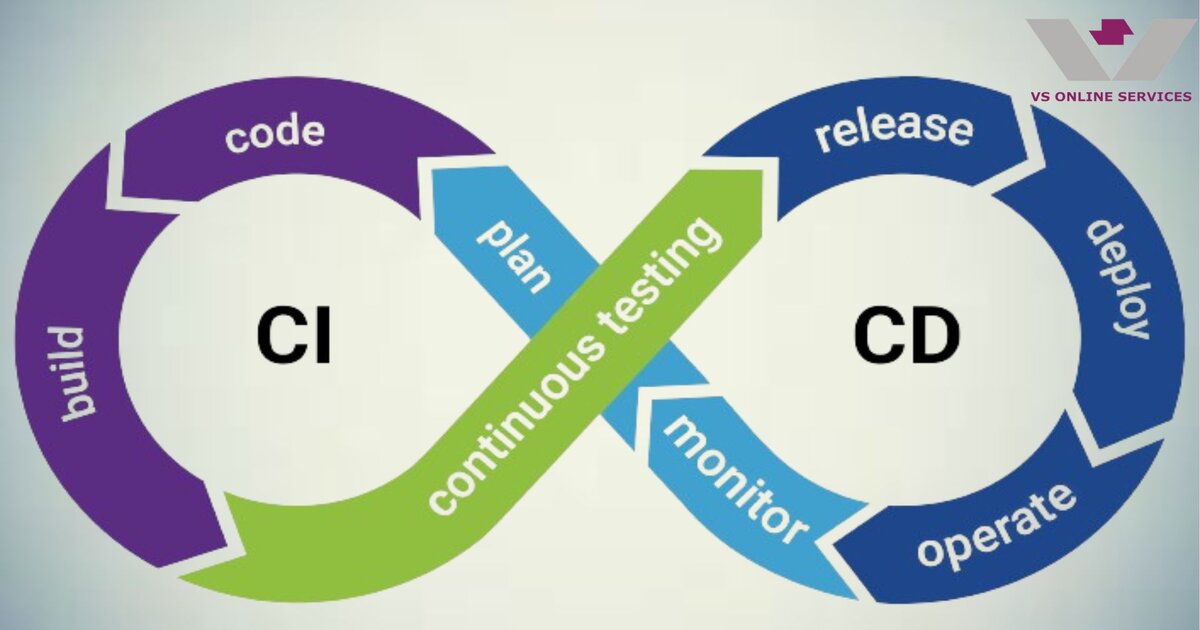28th May 2024
Web App Development Process: A Comprehensive Guide
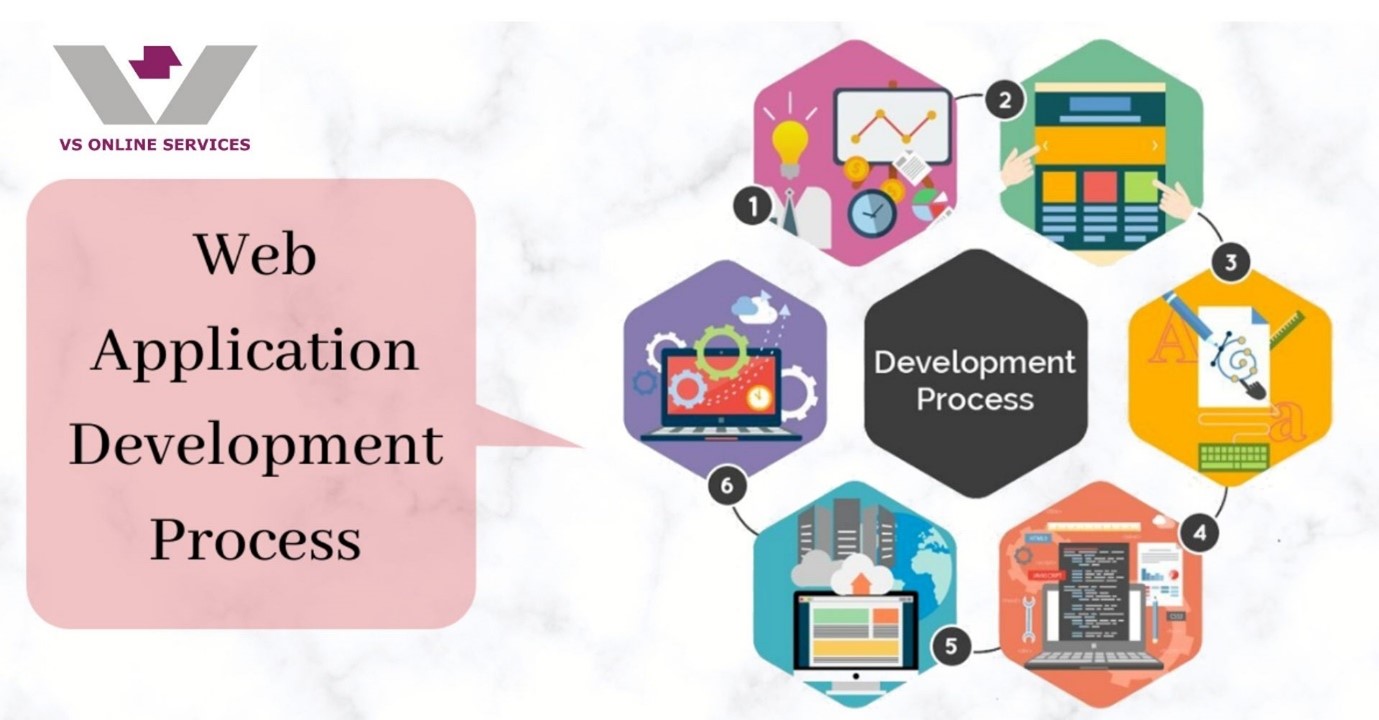
Web apps have transformed how we communicate and conduct business, making it easier to share information with friends, family, and colleagues. They are an integral part of our daily lives, used on the go, in homes, and offices. Millions of people use web apps every day, benefiting from their functionality and convenience. The development of web apps is a complex yet rewarding process that requires careful planning and execution.
In this blog, we will break down the entire process of web app development, covering the process model, flowchart, steps, stages, types, benefits, and more. This comprehensive guide will provide all the information you need in one place, so you don't have to search for each topic separately.
What Is a Web Application Development Process?
The web application development process consists of several stages that are essential for creating a successful web app. These stages include:
1. Planning
This stage involves gathering information about how people will use your application and what they expect from it. Consider potential problems and whether your idea is feasible before moving forward.
2. Designing
After deciding on a design for your app, this step involves working out the visual elements so that it looks appealing when viewed online or in print. Use images and videos if necessary but ensure the design is user-friendly.
3. Development
During this stage, you create new features and functionality on top of existing code bases like HTML5, CSS3, and JavaScript.
Website vs. Web App Development Process
Web applications are more advanced than websites due to their interactive and dynamic nature. They can be used on both mobile devices and computers, eliminating the need for multiple versions for each platform. The main differences between web apps and websites include:
- Web Apps: Dynamic, respond to user input, require authentication, have complex functions, need to be pre-compiled, and have a complex integration process.
- Websites: Static, provide information, authentication optional, simple content, no pre-assembly needed, and simple integration process.
Why Do Businesses Need a Web App?
Businesses benefit from web apps in numerous ways:
- Improve Customer Experience: Provide an easy-to-use platform for customers to access information anytime, anywhere.
- Increase Sales: Build online stores that offer convenience and access to new revenue streams like subscription services.
- Enhance Efficiency: Provide employees with real-time access to data, reducing time spent on manual tasks.
- Boost Productivity: Use time-tracking tools to monitor tasks and focus on important work.
Web Application Architecture: Components and Types
Web application architectures typically have three tiers: application, middleware, and database. They handle data requests and ensure user data validity, record management, and access permissions. The three core components of a web application architecture are:
- Client-Side: Interacts with users and handles presentation logic.
- Web Server: Manages business logic and routes user requests.
- Database Server: Provides data management and handles data-related tasks.
Client-Side Web App Development Frameworks
- React.js: For single-page applications and reusable UI components.
- AngularJS: Uses HTML as a template language and extends HTML syntax.
- Vue.js: Suitable for developing simple and complex UIs.
- HTML: Structures web page content.
- CSS: Defines styles for elements and separates content from layout.
- JavaScript: Enhances UI/UX and reduces server load.
- Node.js: Implements dynamic interactions on the client side.
Server-Side Web App Development Frameworks
- Ruby on Rails: Time-efficient and ideal for enterprise web apps.
- PHP: Quick, adaptable, and practical for dynamic web pages.
- Java: Provides stability and security for web and mobile applications.
- Python and Django: Handles backend development tasks effectively.
- NodeJS: Scalable runtime environment for network and server-side apps.
- .NET: Offers a robust caching system and automatic monitoring.
Popular Database Servers
- MySQL: Emphasizes stability and robustness, ideal for web development.
- Oracle: Used by major companies for its stability and scalability.
- PostgreSQL: Known for its advanced features and reliability.
- MongoDB: Handles document data and is suitable for object-oriented languages.
- DynamoDB: Provides built-in security measures and quick data retrieval.
Types of Web Applications
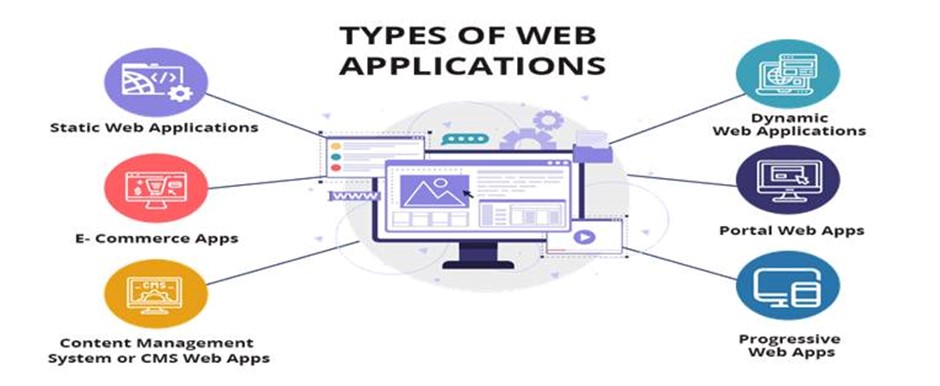
1. Dynamic Web Applications
Dynamic web applications interact with users in real-time and process data to provide customized responses based on user input. These applications are more complex and interactive compared to static web applications.
Characteristics:
- Interactivity: They respond to user inputs and can provide real-time updates.
- Server-Side Processing: These applications often require server-side scripting languages like PHP, ASP.NET, or Ruby on Rails to manage user interactions and data processing.
- Database Integration: Typically connected to a database to store and retrieve user data dynamically.
Use Cases:
- Social Media Platforms: Facebook, Twitter.
- E-commerce Websites: Amazon, eBay.
- Online Learning Platforms: Coursera, Udemy.
Example: Facebook is an excellent example of a dynamic web application. It allows users to interact with each other, post updates, like, and comment in real-time.
2. Portal Web Applications
Portal web applications serve as a gateway to access a variety of services and resources. Users can log in and access personalized information based on their profiles.
Characteristics:
- User Authentication: Requires users to log in to access services.
- Personalized Content: Provides customized information and resources based on user profiles.
- Integrated Services: Combines multiple services such as emails, forums, and dashboards.
Use Cases:
- Employee Portals: Used by companies for internal communications and resources.
- Educational Portals: Used by schools and universities to provide students with access to resources and coursework.
- Patient Portals: Used by healthcare providers to offer patients access to medical records and appointment scheduling.
Example: A university's student portal allows students to access their grades, course materials, and communicate with professors and peers.
3. Single Page Applications (SPAs)
Single Page Applications load a single HTML page and dynamically update content as the user interacts with the app. This approach provides a more fluid and responsive user experience.
Characteristics:
- Single HTML Page: The application loads a single HTML page and updates dynamically without refreshing the page.
- Client-Side Rendering: Uses frameworks like Angular, React, or Vue.js to render content on the client side.
- Fast Performance: Reduces server load and improves performance by loading only necessary content.
Use Cases:
- Email Services: Gmail.
- Social Media Platforms: Twitter.
- Online Collaboration Tools: Trello, Slack.
Example: Gmail is a single page application where the inbox, emails, and other functionalities load dynamically without refreshing the page.
4. Static Web Applications
Static web applications consist of fixed content that does not change in response to user interactions. They are simple to develop and host.
Characteristics:
- Fixed Content: Displays the same content for all users without dynamic interaction.
- Minimal Server-Side Logic: Primarily uses HTML, CSS, and JavaScript.
- Easy to Host: Can be hosted on simple web servers without complex infrastructure.
Use Cases:
- Portfolio Websites: Personal portfolios showcasing work.
- Company Brochure Sites: Static information about a company and its services.
- Informational Blogs: Blogs with static content and articles.
Example: A personal portfolio website showcasing a developer's projects, skills, and contact information.
5. Multi-Page Applications (MPAs)
Multi-Page Applications consist of multiple pages, each requiring a full page reload when navigating to different sections.
Characteristics:
- Multiple HTML Pages: Each page is a separate HTML document that reloads completely when accessed.
- Complex Navigation: More suitable for large applications with complex structures.
- SEO-Friendly: Easier to optimize for search engines due to distinct URLs for each page.
Use Cases:
- Corporate Websites: Detailed information about the company, products, and services.
- E-commerce Sites Online stores with multiple product categories and pages.
- Content-Rich Sites: News websites, blogs with multiple articles.
Example: Amazon's e-commerce website, where navigating through different product categories and pages involves full page reloads.
6. Progressive Web Applications (PWAs)
Progressive Web Applications combine the best features of web and mobile apps, providing a native app-like experience on the web.
Characteristics:
- Responsive Design: Adapts to different screen sizes and devices.
- Offline Capabilities: Can work offline or with poor network conditions using service workers.
- App-Like Experience: Provides a seamless, app-like experience with features such as push notifications.
Use Cases:
- E-commerce: Providing a seamless shopping experience across devices.
- News Platforms: Allowing users to access content offline.
- Social Media: Enhancing user engagement with push notifications and offline capabilities.
Example: Starbucks' PWA allows customers to browse the menu, customize orders, and even work offline, providing a seamless experience similar to a native mobile app.
7. Content Management Systems (CMS)
Content Management Systems are used to create, manage, and modify digital content without requiring specialized technical knowledge.
Characteristics:
- User-Friendly Interface: Allows non-technical users to create and manage content.
- Templates and Plugins: Offers a variety of templates and plugins to extend functionality.
- Scalable: Can be used for small blogs to large enterprise websites.
Use Cases:
- Corporate Blogs: For regular updates and content publication.
- News Websites: For managing and publishing news articles.
- E-commerce Sites: For managing product information and content.
Example: WordPress is a popular CMS that powers millions of websites, offering extensive customization through themes and plugins.
8. Animated Web Applications
Animated web applications use animation to enhance user engagement and interaction. They are often used in creative industries to make websites more visually appealing.
Characteristics:
- Rich Media: Incorporates animations, GIFs, and interactive elements.
- Engaging Design: Aims to capture and retain user attention.
- SEO Challenges: Animation-heavy websites may face challenges in SEO optimization.
Use Cases:
- Marketing Campaigns: To create visually stunning landing pages.
- Creative Portfolios: For designers and artists to showcase their work.
- Educational Sites: To create engaging, interactive learning experiences.
Example: An animated web application for a marketing campaign might use interactive graphics and animations to highlight key features of a product.
9. E-commerce Web Applications
E-commerce web applications facilitate online buying and selling of goods and services. They include features like shopping carts, payment gateways, and order management.
Characteristics:
- Transaction Integration: Supports online payments and transactions.
- Product Management: Allows businesses to manage product listings and inventories.
- User Accounts: Enables customers to create accounts, track orders, and view purchase history.
Use Cases:
- Online Retailers: Amazon, eBay.
- Marketplaces: Etsy, Alibaba.
- Food Delivery Services: Swiggy, Zomato.
Example: Amazon's e-commerce platform allows users to browse products, make purchases, and manage their orders through a comprehensive online system.
By understanding these types of web applications, businesses can better decide which type suits their needs and how to approach the development process to achieve the desired results.
Web App Development Process Flow: A 10-Step Process
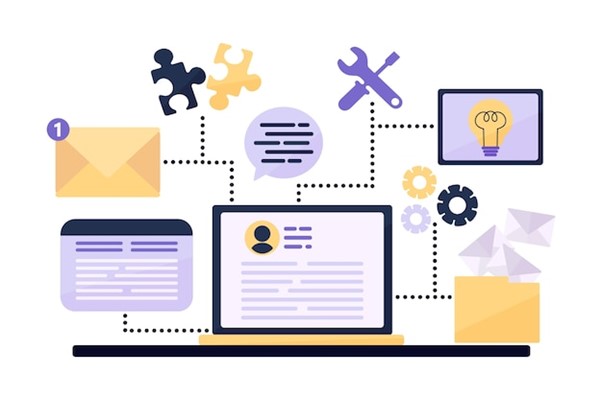
1. Idea and Conceptualization
The first step involves generating and refining the core idea of the web application. This phase includes brainstorming sessions and initial discussions to outline the primary goals and objectives.
Key Activities:
- Brainstorming Sessions: Gather key stakeholders to discuss ideas and possibilities.
- Market Research Analyse market trends, competitors, and potential user needs to validate the idea.
- Define Objectives: Clearly outline the goals and what the application aims to achieve.
- Feasibility Study: Assess technical and financial feasibility, ensuring the idea can be realistically implemented.
Outcome: A well-defined concept and clear objectives for the web application.
2. Requirement Analysis and Planning
This phase involves gathering detailed requirements from stakeholders and planning the project. It includes defining the scope, functionalities, and user roles.
Key Activities:
- Stakeholder Meetings: Engage with stakeholders to understand their needs and expectations.
- Requirement Gathering: Document detailed functional and non-functional requirements.
- Scope Definition: Clearly define what will be included in the project and what will not.
- Project Plan: Create a comprehensive project plan with timelines, milestones, and resource allocation.
Outcome: A detailed requirement specification document and a project plan.
3. Designing the Architecture
Designing the system architecture involves planning the overall structure of the web application, including the front-end, back-end, database, and third-party integrations.
Key Activities:
- System Architecture Design: Outline the architecture, including client-server interactions, APIs, and data flow.
- Technology Stack Selection: Choose the appropriate technologies and tools for front-end, back-end, and database development.
- Database Design: Plan the database schema and data relationships.
- Scalability and Security Considerations: Ensure the architecture can handle future growth and is secure.
Outcome: A detailed architectural blueprint and selected technology stack.
4. UI/UX Design
The User Interface (UI) and User Experience (UX) design phase focuses on creating an intuitive and visually appealing interface that provides a seamless user experience.
Key Activities:
- Wireframing: Create low-fidelity wireframes to outline the layout and structure of the application.
- Prototyping: Develop high-fidelity prototypes to visualize the final design and user interactions.
- User Testing: Conduct usability testing with potential users to gather feedback and refine the design.
- Responsive Design: Ensure the design is responsive and works well on various devices and screen sizes.
Outcome: Finalized UI/UX design prototypes and design assets.
5. Front-End Development
Front-end development involves converting the UI/UX design into a functional user interface using HTML, CSS, JavaScript, and front-end frameworks.
Key Activities:
- HTML/CSS Coding: Convert design prototypes into static HTML and CSS code.
- JavaScript Development: Add interactivity and dynamic features using JavaScript.
- Framework Implementation: Use frameworks like React, Angular, or Vue.js for efficient development.
- Cross-Browser Compatibility: Ensure the application works consistently across different browsers.
Outcome: A functional front-end interface.
6. Back-End Development
Back-end development focuses on server-side logic, database management, and integration of third-party services.
Key Activities:
- Server-Side Coding: Develop server-side logic using languages like Node.js, Python, Ruby, or PHP.
- API Development: Create RESTful or GraphQL APIs for communication between front-end and back-end.
- Database Integration: Implement and integrate the database, ensuring efficient data storage and retrieval.
- Authentication and Authorization: Develop user authentication and access control mechanisms.
Outcome: A robust and scalable back-end system.
7. Integration
Integration involves connecting the front-end and back-end components and ensuring they work seamlessly together.
Key Activities:
- API Integration: Connect the front-end with back-end APIs.
- Third-Party Services: Integrate third-party services like payment gateways, social media logins, and analytics tools.
- Data Synchronization: Ensure data consistency and synchronization between different components.
Outcome: A fully integrated web application ready for testing.
8. Testing
Testing is crucial to identify and fix bugs, ensuring the application functions correctly and provides a good user experience.
Key Activities:
- Unit Testing: Test individual components and modules for correctness.
- Integration Testing: Verify that different modules work together as expected.
- System Testing: Test the entire system for compliance with requirements.
- User Acceptance Testing (UAT): Conduct testing with actual users to validate functionality and usability.
- Performance Testing: Ensure the application performs well under various load conditions.
- Security Testing: Identify and fix potential security vulnerabilities.
Outcome: A thoroughly tested web application with minimal bugs and issues.
9. Deployment
Deployment involves publishing the web application to a production environment where users can access it.
Key Activities:
- Server Setup: Configure the production server and environment.
- Code Deployment: Deploy the codebase to the production server.
- Database Migration: Migrate the database to the production environment.
- Domain Configuration: Set up domain names and SSL certificates for secure access.
- Monitoring Setup: Implement monitoring tools to track application performance and issues.
Outcome: A live web application accessible to users.
10. Maintenance and Updates
Post-deployment, the web application requires ongoing maintenance and updates to fix bugs, improve performance, and add new features.
Key Activities:
- Bug Fixes: Continuously monitor and fix any issues reported by users.
- Performance Optimization: Regularly optimize the application for better performance.
- Feature Enhancements: Add new features and improvements based on user feedback.
- Security Patches: Apply security patches and updates to protect against vulnerabilities.
- Regular Backups: Implement a backup strategy to ensure data safety and recovery.
Outcome: A well-maintained, updated, and secure web application.
By following this detailed 10-step process, developers can ensure a systematic and efficient approach to web application development, leading to a successful and high-quality product.
Conclusion
Web application development is a multifaceted process that requires careful planning, execution, and maintenance. Each phase, from conceptualization to maintenance, plays a critical role in ensuring the success of the final product.
Key Takeaways:
- Comprehensive Planning: The foundation of a successful web application lies in thorough planning and requirement analysis. Understanding user needs and market trends is essential to align the application with its intended goals.
- User-Centric Design: A focus on UI/UX design ensures the application is not only functional but also user-friendly and visually appealing. Prototyping and user testing are crucial to refining the user experience.
- Robust Development: Both front-end and back-end development are critical, with each requiring a solid understanding of technologies and best practices. Ensuring seamless integration between these components is vital for a smooth user experience.
- Rigorous Testing: Quality assurance through extensive testing helps identify and rectify bugs and performance issues, leading to a reliable and efficient web application.
- Continuous Improvement: Post-deployment, continuous monitoring, maintenance, and updates are necessary to keep the application secure, efficient, and relevant to users’ evolving needs.
- Scalability and Security Designing with scalability and security in mind from the outset prevents future complications and ensures the application can grow and adapt to increased demands.
By adhering to these principles and following a structured process, developers can create high-quality web applications that meet user expectations and stand the test of time. The journey from a simple idea to a fully functional web application involves collaboration, dedication, and an iterative approach to improvement, ultimately resulting in a successful digital solution.


